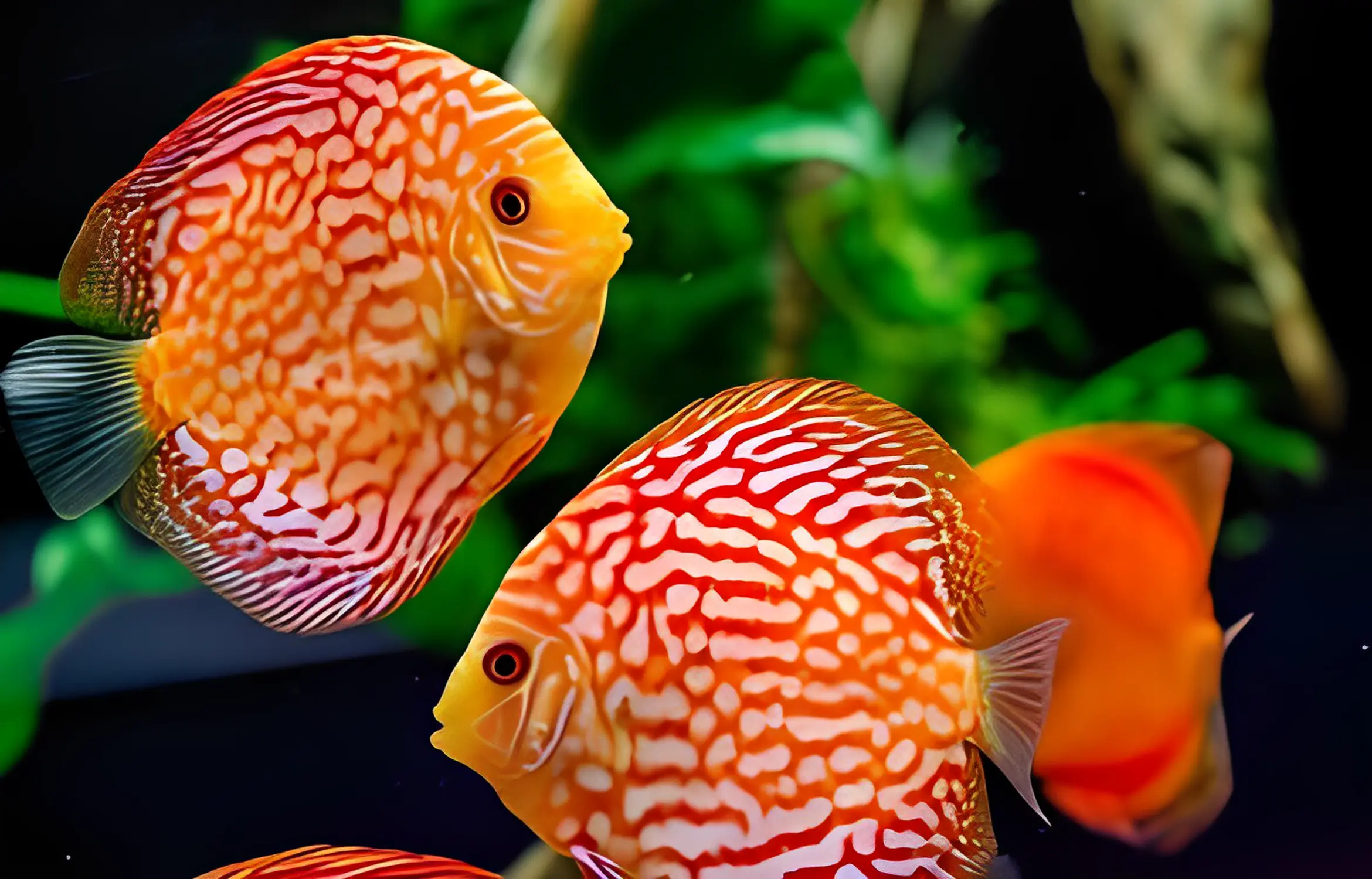Welcome to the underwater kingdom of discus fish! As the majestic rulers of the aquarium, these vibrant and graceful creatures never fail to captivate our hearts. But providing top-notch care for these regal beauties can be quite a challenge.
In this article, we will dive deep into the realm of discus fish care, arming you with advanced tips to ensure the health and happiness of your underwater kings and queens. From water parameters and tank size to feeding habits and breeding techniques, we will leave no stone unturned in our quest to unlock the secrets of maintaining a thriving discus tank.
Our brand voice is all about sharing knowledge and helping aquarium enthusiasts build a strong foundation of expertise. With that in mind, we have crafted this comprehensive guide to provide you with all the essential information you need to give your discus fish the royal treatment they deserve.
So, whether you’re a seasoned discus keeper or just starting your aquarist journey, get ready to immerse yourself in the captivating world of discus fish and discover how to create a truly enchanting underwater oasis for these magnificent creatures.
Understanding the Needs of Discus Fish
Discus fish, also known as the “King of the Aquarium,” are native to the Amazon River basin in South America. They are known for their vibrant colors, unique body shape, and peaceful temperament. To provide the best care for your discus fish, it’s crucial to understand their specific needs.
Water Parameters
Discus fish require clean and well-maintained water for optimal health. The ideal water parameters for discus fish include a pH level between 6.0 and 7.0, a temperature range of 82°F to 86°F (28°C to 30°C), and soft, slightly acidic water. Maintaining stable water conditions is essential, as discus fish are sensitive to fluctuations in temperature and water quality.
Tank Size and Setup
When it comes to tank size, bigger is always better for discus fish. A larger tank provides more swimming space and helps maintain stable water conditions. A minimum tank size of 55 gallons is recommended for a small group of discus fish. It’s important to provide ample hiding spots and vegetation in the tank to mimic their natural habitat and create a stress-free environment.
Tank Mates
Discus fish are peaceful by nature and prefer to be kept with other peaceful species. Avoid housing them with aggressive fish or those that may nip at their fins. Suitable tank mates for discus fish include tetras, corydoras catfish, and peaceful bottom-dwelling species. It’s important to research and choose compatible tank mates to ensure a harmonious community tank.
Water Conditions and Temperature for Discus Fish
Maintaining optimal water conditions is crucial for the health and well-being of discus fish. In their natural habitat, discus fish thrive in warm, soft, and slightly acidic water. Here are some key factors to consider when maintaining water conditions for your discus tank.
Filtration and Water Quality
A high-quality filtration system is essential to keep the water in your discus tank clean and free from harmful toxins. Use a combination of mechanical, biological, and chemical filtration to ensure optimal water quality. Regular water changes of 20-30% every week are recommended to remove accumulated waste and maintain stable water parameters.
Temperature Control
Discus fish are tropical fish and require warm water to thrive. A consistent temperature range of 82°F to 86°F (28°C to 30°C) should be maintained. Use a reliable aquarium heater and thermometer to monitor and regulate the water temperature. Sudden temperature fluctuations can cause stress and compromise the health of your discus fish.
pH and Water Hardness
Discus fish prefer slightly acidic water with a pH level between 6.0 and 7.0. Regular testing of pH levels is essential to ensure optimal water conditions. Water hardness should also be monitored, and if necessary, it can be adjusted by using additives or reverse osmosis water to create a softer environment for your discus fish.
Feeding Discus Fish: Best Practices and Recommended Diet
Proper nutrition is vital for the overall health and vibrant colors of discus fish. Offering a balanced and varied diet will help keep your discus fish in peak condition. Here are some best practices and recommended foods for feeding discus fish.
Know more about discus fish feeding & nutrition
High-Quality Pellets and Flakes
A high-quality discus fish pellet or flake food should be the staple diet for your discus. Look for a brand that offers a balanced nutritional profile, including a mix of proteins, fats, vitamins, and minerals. Feed your discus fish small amounts of pellets or flakes multiple times a day, ensuring they consume the food within a few minutes.
Frozen and Live Foods
To provide additional variety and nutrition, supplement your discus fish’s diet with frozen or live foods. Bloodworms, brine shrimp, daphnia, and blackworms are excellent options that mimic their natural diet. These foods can be fed once or twice a week to provide essential nutrients and promote natural foraging behavior.
Avoid Overfeeding
Overfeeding can lead to poor water quality and health issues in discus fish. It’s important to feed them small amounts of food at regular intervals rather than a large quantity at once. Monitor their feeding behavior and adjust the amount accordingly. Remember, it’s better to slightly underfeed than to overfeed your discus fish.
Maintaining the Health of Discus Fish
Keeping your discus fish healthy is the key to their long-term well-being. Regular observation and proper care can help prevent common health issues and ensure a thriving discus tank. Here are some essential tips for maintaining the health of your discus fish.
Regular Water Changes
Regular water changes are crucial for maintaining optimal water quality and preventing the buildup of harmful toxins. As mentioned earlier, perform weekly water changes of 20-30% to remove accumulated waste and replenish the tank with fresh water. This will help keep your discus fish healthy and reduce the risk of diseases.
Observation and Early Detection
Regular observation of your discus fish is essential to detect any signs of illness or stress early on. Look out for changes in behavior, appetite, coloration, or any physical abnormalities. If you notice any unusual symptoms, take immediate action and consult a knowledgeable fish veterinarian or experienced aquarist for proper diagnosis and treatment.
Quarantine New Fish
When introducing new discus fish to your tank, it’s crucial to quarantine them separately for a few weeks. This helps prevent the spread of diseases or parasites to your existing fish population. During quarantine, observe the new fish closely for any signs of illness before introducing them to the main tank.
Common Diseases and Treatments for Discus Fish
Despite your best efforts, discus fish can sometimes fall prey to diseases. Early detection and prompt treatment are crucial for their recovery. Here are some common diseases that affect discus fish and their recommended treatments.
Hole in the Head Disease
Hole in the Head Disease is a common ailment that affects discus fish. It is characterized by lesions or pits on the head and lateral line. To treat this disease, maintain optimal water conditions, perform regular water changes, and consider adding a high-quality vitamin supplement to their diet. Severe cases may require medication, so consult a fish veterinarian for proper diagnosis and treatment options.
Ich (White Spot Disease)
Ich, or White Spot Disease, is caused by a parasite and manifests as small white spots on the fish’s body and fins. To treat Ich, raise the water temperature to 86°F (30°C) and add a commercial medication specifically formulated to treat this disease. Perform regular water changes and monitor the fish closely for signs of improvement.
Bacterial Infections
Bacterial infections can occur due to poor water quality or physical injuries. Symptoms may include red sores, ulcers, or fin rot. To treat bacterial infections, maintain optimal water conditions, perform regular water changes, and add a broad-spectrum antibiotic medication to the tank. Consult a fish veterinarian for proper diagnosis and guidance on medication.
Breeding Discus Fish: Tips and Techniques
Breeding discus fish can be a rewarding experience for avid aquarists. However, it requires careful planning and attention to detail. Here are some essential tips and techniques for successful discus fish breeding.
Pair Selection
Choose healthy and mature discus fish for breeding. Look for pairs that exhibit compatible behavior and physical characteristics. Conditioning the breeding pair with high-quality food and maintaining optimal water conditions will increase the chances of successful breeding.
Spawning Tank Setup
Create a separate spawning tank for your breeding discus fish. The tank should be equipped with flat surfaces, such as slate or PVC pipes, for the pair to lay their eggs. Maintain stable water conditions and provide suitable lighting to stimulate breeding behavior. Perform regular water changes to ensure optimal water quality.
Egg Laying and Incubation
When the pair is ready to spawn, the female will lay eggs on the chosen surface. The male will then fertilize the eggs. It’s important to remove the eggs from the breeding tank and transfer them to a separate tank for incubation. Maintain optimal water conditions and provide gentle aeration to promote healthy egg development.
Decorating Your Discus Fish Tank for Optimal Comfort
Creating a visually appealing and comfortable environment is essential for the well-being of your discus fish. Here are some tips for decorating your discus fish tank.
Substrate and Plants
Choose a fine-grained substrate, such as sand or smooth gravel, to mimic the natural habitat of discus fish. Live plants, such as Amazon swords or Java fern, provide hiding spots and help maintain water quality. Avoid sharp or rough decorations that may injure your discus fish.
Lighting
Proper lighting is essential for the overall health and vibrant colors of your discus fish. Use LED lights that mimic natural sunlight to provide a balanced spectrum. Avoid excessive brightness or direct light, as it may cause stress to your discus fish.
Hiding Spots and Territories
Discus fish appreciate areas in the tank where they can retreat and establish their territories. Use driftwood, rocks, or artificial caves to create hiding spots and break the line of sight in the tank. This will help reduce stress and promote natural behavior.
Conclusion: Enjoying the Beauty and Elegance of Discus Fish
Congratulations! You have now learned the advanced care tips for the king of the aquarium, discus fish. By understanding their specific needs, maintaining optimal water conditions, providing a balanced diet, and keeping a close eye on their health, you can create a thriving discus tank.
Remember, patience and dedication are key when caring for discus fish. With the knowledge gained from this comprehensive guide, you are well-equipped to create a truly enchanting underwater oasis for these magnificent creatures. So, dive in and enjoy the beauty and elegance of discus fish in your own home aquarium!

